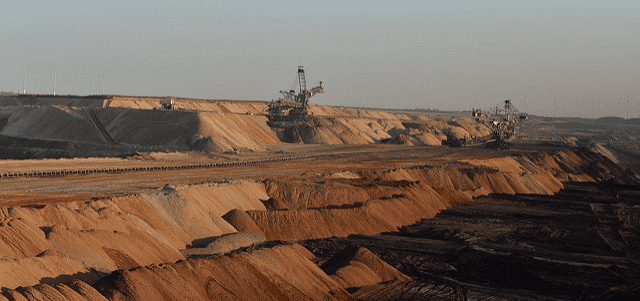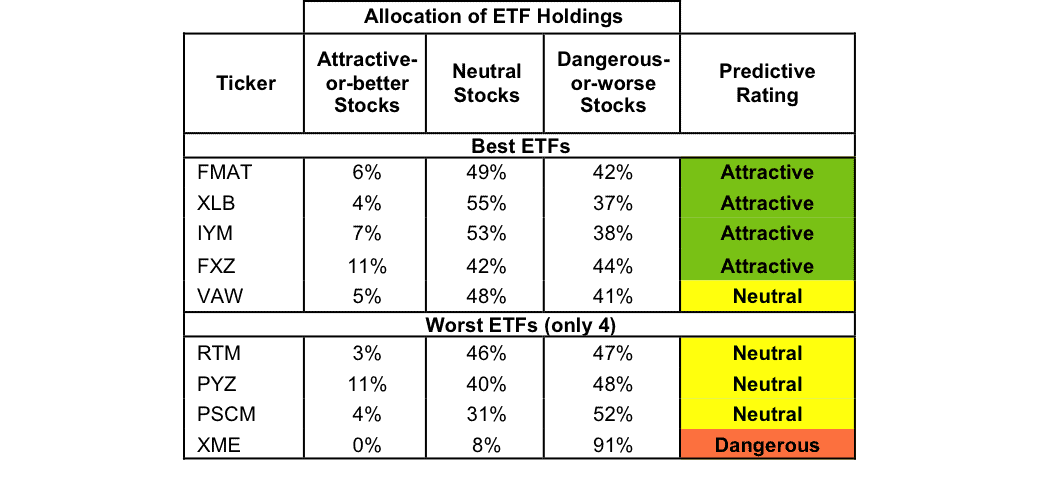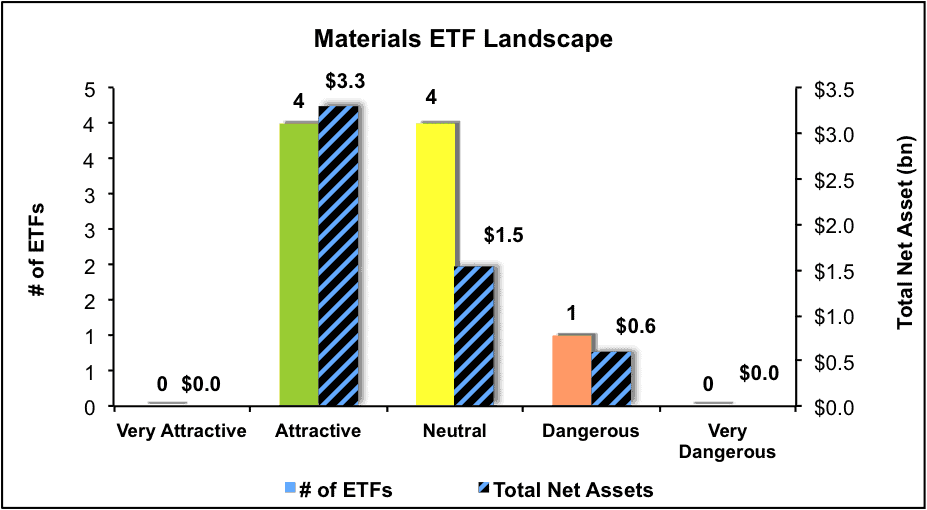Sector Analysis 3Q16
The Materials sector ranks fifth out of the ten sectors as detailed in our 3Q16 Sector Ratings for ETFs and Mutual Funds report. Last quarter, the Materials sector ranked second. It gets our Neutral rating, which is based on an aggregation of ratings of nine ETFs and 11 mutual funds in the Materials sector as of July 14, 2016. See a recap of our 2Q16 Sector Ratings here.
Figure 1 ranks from best to worst all nine Materials ETFs and Figure 2 shows the five best and worst-rated Materials mutual funds. Not all Materials sector ETFs and mutual funds are created the same. The number of holdings varies widely (from 23 to 122). This variation creates drastically different investment implications and, therefore, ratings.
Investors seeking exposure to the Materials sector should buy one of the Attractive-or-better rated ETFs from Figure 1.
Figure 1: ETFs with the Best & Worst Ratings – Top 5
* Best ETFs exclude ETFs with TNAs less than $100 million for inadequate liquidity.
Sources: New Constructs, LLC and company filings
Figure 2: Mutual Funds with the Best & Worst Ratings – Top 5
* Best mutual funds exclude funds with TNAs less than $100 million for inadequate liquidity.
Sources: New Constructs, LLC and company filings
Fidelity MSCI Materials Index (FMAT) is the top-rated Materials ETF and Fidelity Advisor Materials Fund (FMFEX) is the top-rated Materials mutual fund. FMAT earns an Attractive rating and FMFEX earns a Neutral rating.
State Street SPDR S&P Metals & Mining ETF (XME) is the worst rated Materials ETF and Rydex Series Basic Materials Fund (RYBMX) is the worst rated Materials mutual fund. XME earns a Dangerous rating and RYBMX earns a Very Dangerous rating.
158 stocks of the 3000+ we cover are classified as Materials stocks.
LyondellBasell Industries NV (LYB: $77/share) is one of our favorite stocks held by FMAT and earns a Very Attractive rating. Since 2011, LYB has grown after-tax profit (NOPAT) by 10% compounded annually. The company has improved its return on invested capital (ROIC) from 17% in 2011 to a top-quintile 23% over the last twelve months. Furthermore, the company has generated cumulative free cash flow of $14.8 billion from 2012-2015 and currently earns an 8% FCF yield. Despite the improving profits and profitability, LYB is significantly undervalued. At its current price of $77/share, LYB has a price-to-economic book value (PEBV) ratio of 0.7. This ratio means that the market expects LyondellBasell’s NOPAT to permanently decline by 30%. If LYB can grow NOPAT by just 2% compounded annually for the next decade, the stock is worth $119/share today – a 55% upside.
Cliffs Natural Resources (CLF: $7/share) is one of our least favorite stocks held by XME and earns a Very Dangerous rating. Over the past decade, Cliffs’ NOPAT has declined by 14% compounded annually. Additionally, the firm’s ROIC has fallen from a once impressive 24% in 2010, to a bottom-quintile 0% over the last twelve months. Despite the fundamental deterioration, CLF is priced for significant profit growth. To justify its current price of $7/share, CLF must grow NOPAT by 16% compounded annually for the next 12 years. This expectation seems overly optimistic given the past decade of profit declines and makes CLF one to avoid.
Figures 3 and 4 show the rating landscape of all Materials ETFs and mutual funds.
Figure 3: Separating the Best ETFs From the Worst ETFs
Sources: New Constructs, LLC and company filings
Figure 4: Separating the Best Mutual Funds From the Worst Mutual Funds
Sources: New Constructs, LLC and company filings
This article originally published here on July 15, 2016.
Disclosure: David Trainer and Kyle Guske II receive no compensation to write about any specific stock, sector or theme.
Click here to download a PDF of this report.
Photo Credit: unefunge (Flickr)




